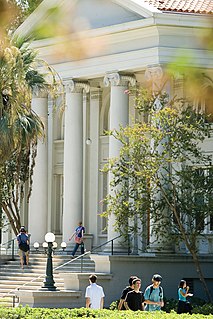
A college is an educational institution or a constituent part of one. A college may be a degree-awarding tertiary educational institution, a part of a collegiate or federal university, an institution offering vocational education, or a secondary school.

A community college is a type of educational institution. The term can have different meanings in different countries: many community colleges have an "open enrollment" for students who have graduated from high school. The term usually refers to a higher educational institution that provides workforce education and college transfer academic programs. Some institutions maintain athletic teams and dormitories similar to their university counterparts.
Technical and further education or simply TAFE, is the common name in English-speaking countries in Oceania for vocational education, as a subset of tertiary education. TAFE institutions provide a wide range of predominantly vocational courses.

Victoria University is a public research university based in Melbourne, Victoria, Australia. It is one of only six dual-sector universities in Australia, providing courses in both higher education and Technical and Further Education (TAFE). 2016 marked VU's centenary as an educational institution and its 25th anniversary as a university.

Undergraduate education is education conducted after secondary education and before postgraduate education. It typically includes all postsecondary programs up to the level of a bachelor's degree. For example, in the United States, an entry-level university student is known as an undergraduate, while students of higher degrees are known as graduate students. Upon completion of a number of required and elective courses as part of an undergraduate program, the student would earn the corresponding degree. In some other educational systems, undergraduate education is postsecondary education up to the level of a master's degree; this is the case for some science courses in Britain and some medicine courses in Europe.

Swinburne University of Technology is a public research university based in Melbourne, Australia. It was founded in 1908 as the Eastern Suburbs Technical College by George Swinburne to serve those without access to further education in Melbourne's eastern suburbs. Its main campus is in Hawthorn, a suburb of Melbourne, 7.5 km from the Melbourne central business district.
An institute of technology is an institution of tertiary education that specializes in engineering, technology, applied science, and natural sciences.
The College of Advanced Education (CAE) was a class of Australian tertiary education institution that existed from 1967 until the early 1990s. They ranked below universities, but above Colleges of Technical and Further Education (TAFE) which offer trade qualification. CAEs were designed to provide formal post-secondary qualifications of a more vocational nature than those available from universities, chiefly in such areas as teaching, nursing, accountancy, fine art and information technology.

The Australian Qualifications Framework (AQF) specifies the standards for educational qualifications in Australia. It is administered nationally by the Australian Government's Department of Industry, with oversight from the States and Territories, through the Standing Council of Tertiary Education Skills and Employment. While the AQF specifies the standards, education and training organisations are authorised by accrediting authorities to issue a qualification.

The Australian College of Theology (ACT) is an Australian higher education provider based in Sydney, New South Wales. The college delivers awards in ministry and theology and was one of the first Australian non-university providers to offer an accredited bachelor's degree and a research doctorate. Over 22,000 people have graduated since the foundation of the college. It is a company limited by guarantee as of September 2007. On 7 October 2022 it was granted university college status by the Tertiary Education Quality and Standards Agency.
Melbourne Polytechnic, formerly NMIT, is a Higher education and vocational education (TAFE) institute located in Melbourne, Australia predominantly in the northern suburbs but also in the south with a campus at Prahran. It has seven campuses located at Preston, Collingwood, Epping, Fairfield, Heidelberg, Prahran, Greensborough, training sites at Broadmeadows, and country training facilities at Eden Park, Yan Yean, and Ararat.
Victoria College was a College of Advanced Education (CAE) in Melbourne, Australia. It was created as a result of the merger on 23 December 1981 of the State College of Victoria colleges at Burwood, Rusden and Toorak with the Prahran College of Advanced Education. In doing so, it became the largest College of Advanced Education in eastern Melbourne.
Swinburne University of Technology Sarawak Campus is the foreign branch campus of Swinburne University and is located in Kuching, Sarawak, Malaysia. Established in 2000, Swinburne Sarawak operates as a partnership between the Sarawak State Government and Swinburne Australia. The initiative behind the Sarawak campus is part of a long term strategy by Swinburne Australia to "globalize its operations and provide its students with international living, working and learning opportunities".
Performing arts education in Australia refers to the teaching of different styles of creative activity that are performed publicly. The performing arts in Australia encompasses many disciplines including music, dance, theatre, musical theatre, circus arts and more. Performing arts education in Australia occurs both formally and informally at all levels of education, including in schools, tertiary institutions and other specialist institutions. There is also a growing body of evidence, from the Australian Council for the Arts and the Parliament of Australia, showing that First Nation's participation in the arts and culture has significant economic, social and cultural benefits to Australia and further supports the outcomes of the Australian governments ‘Closing the Gap’ campaign. There has been an increasing number of scholarships opening up in educational institutions for Indigenous Australians aimed at encouraging this participation in the arts.

Education in Victoria, Australia is supervised by the Department of Education and Training (DET), which is part of the State Government and whose role is to 'provide policy and planning advice for the delivery of education'. It acts as advisor to two state ministers, that for Education and for Children and Early Childhood Development.
Phillip Institute of Technology (PIT) was a tertiary college in northern Melbourne, from 6 January 1982 to 30 June 1992 at which time the school integrated as part of RMIT University. The college's buildings formed RMIT's Bundoora Campus and Coburg Campus. Coburg Campus was closed in 1997, with the site since serving as a series of secondary and primary schools.
The African University College of Communications is a private tertiary institution at Adabraka, Accra, Ghana, for the study and teaching of journalism, communication studies, information technology convergence, business, African Studies, providing opportunities for advanced learning, and practical and professional training for the rapid growth and development of Africa.

Prahran Campus of Melbourne Polytechnic was established in 2013 as a hybrid educational organisation developed and administered by Melbourne Polytechnic when it was known as Northern Melbourne Institute of TAFE (NMIT), offering vocational education courses encompassing Certificate, Diploma, Advanced Diploma levels and Bachelor degrees at Prahran campus.

The University of Professional Studies, Accra (UPSA) formerly known as Institute of Professional Studies (IPS), is a public university in Ghana. The main campus is located in Accra. UPSA is the first university in Ghana to provide both academic and business professional education. The University of Professional Studies Act, 2012 changed the name of the Institute of Professional Studies to University of Professional Studies, Accra. UPSA is nationally and internationally accredited by the National Accreditation Board (Ghana) and the Accreditation Council for Business Schools and Programs (ACBSP) respectively.
The Prahran College of Advanced Education, formerly Prahran College of Technology, was a late-secondary and tertiary institution with a business school, a trade school, and a multi-disciplinary art school that dated back to the 1860s, populated by instructors and students who were among Australia’s significant artists, designers and performers.











